- Sleep disorders affect up to 70 million Americans, leading to chronic fatigue and concentration difficulties.
- Common sleep disorders include insomnia, sleep apnea, restless leg syndrome, parasomnia, and narcolepsy.
- Treatment options range from red light therapy for insomnia, medication for parasomnia, and sleep studies for sleep apnea and narcolepsy.
- Preventive measures like avoiding stimulants, regular exercise, and relaxation techniques can improve sleep quality.
- Consulting your doctor and connecting with professional organizations can provide additional support.
Sleep disorders are a condition that affects millions of people. It can manifest in various ways, from insomnia to sleep apnea. Unfortunately, many individuals are unaware that they have a sleep disorder and carry on with their day-to-day lives experiencing chronic fatigue, irritability, and concentration difficulties. In this blog post, we will provide detailed information on the most common sleep disorders to help raise awareness of these disorders and promote healthier sleep habits.
Sleep Disorders in the U.S.
Many Americans are struggling to get quality sleep. It’s estimated that around 50-70 million adults in the U.S. have a sleep disorder, and many don’t even realize it. Here’s what you need to know about these disorders and ways to deal with them.
Insomnia
Insomnia is a sleep disorder characterized by a persistent inability to fall and stay asleep. It can be caused by several factors, including psychological, physical, and medication. Regarding physical factors, chronic pain is one of the leading reasons for insomnia. People dealing with chronic pain often find it difficult to relax and fall asleep, leading to insomnia. A robust red light therapy treatment is one way to deal with this. Red light has been associated with improved sleep quality and enhanced relaxation. This can be a great way to help those suffering from insomnia.

Sleep Apnea
Sleep apnea is a condition resulting from the sporadic cessations of breathing during sleep. Obstructive sleep apnea (OSA) is a disturbing sleeping disorder that occurs when the airways become partially or totally obstructed during rest.
At the same time, central sleep apnea (CSA) occurs when the brain stops sending signals to the muscles that regulate breathing. Common sleep apnea symptoms include loud snoring, headaches in the morning, and excessive daytime sleepiness. Your physician may recommend a sleep study to diagnose this disorder, which will involve monitoring your brain wave activity, heart rate, breathing pattern, and oxygen levels.
Restless Leg Syndrome
Restless Leg Syndrome (RLS) is a condition that typically manifests in the evening or at night, causing an intense urge to move your legs due to uncomfortable sensations. Individuals with RLS often kick or move their legs uncontrollably to alleviate the feeling. The primary treatments for RLS include exercise, avoiding caffeine, and medication. Increasing your intake of magnesium or iron may also bring relief.
Parasomnia
Parasomnia is a condition that describes unwanted events that occur during sleep, such as sleepwalking, nightmares, sleep talking, and bedwetting. The treatment for parasomnia depends on the specific event occurring. Sleepwalking, for example, may be improved by preventive measures in the household or medications. If you or someone you know experiences parasomnia, seeking the guidance of a healthcare professional can help determine the best course of action.
Narcolepsy
Narcolepsy is a neurological sleep disorder that causes unpredictable bouts of falling asleep during the day. Other symptoms can include loss of muscle control and vivid nightmares. Narcolepsy is caused by a lack of a brain chemical called orexin that controls sleep and wakefulness. A medical professional can diagnose narcolepsy through a sleep study, allowing the doctor to provide appropriate medication and lifestyle changes to help manage the disorder.
Preventing Sleep Disorders
The best way to prevent sleep disorders is to take a proactive approach and improve your sleep habits. Here are some tips:

Avoid Stimulants
One of the best ways to avoid sleep disturbances is to limit your intake of stimulants like caffeine. Stimulants such as coffee, tea, and energy drinks can disrupt the body’s natural circadian rhythm and interfere with quality sleep. Consider avoiding these stimulants after lunchtime or early in the afternoon.
Regular Exercise
Exercising regularly has been shown to improve sleep quality, promote relaxation, and help regulate your body’s sleep-wake cycle. Aim to get at least 30 minutes of moderate exercise each day.
Relaxation Techniques
Relaxation techniques such as yoga, deep breathing exercises, and guided imagery can be effective in helping you relax and prepare for a good night’s sleep. Spend some time before bed focusing on calming your mind and body.
Managing stress
Stress can play a major role in sleep disturbances. Taking steps to manage your stress levels, such as meditation or journaling, may help promote better sleep quality. Consider making relaxation a part of your nightly routine by taking deep breaths or stretching for a few minutes.
Adopting healthy sleep habits and being aware of the signs and symptoms of sleep disorders can help you get a better night’s rest. If you feel that you may have a sleep disorder, it is important to see your doctor for a diagnosis and talk to them about treatment options. Additionally, connecting with professional organizations or support groups can provide you with resources and support.
Sleep is essential to overall health, and it’s important to take care of your sleep hygiene. With better sleep habits, you can get the quality rest you need and live healthier lives.

